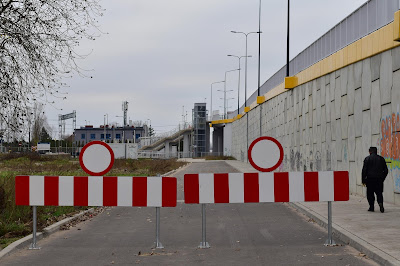Below: round the back of W-wa Zachodnia (Warsaw West) railway station, rows of social wagons housing workers on the big infrastructure project that will be renovating W-wa Główna station, further east. The skyline of Warsaw is rising ever higher...
Below: approaching W-wa Główna - this was the former terminus for commuter trains coming in from the west. It is being rebuilt to serve the same purpose during the planned reconstruction of the transversal lines crossing underneath Central Warsaw. Behind it rise the new buildings around Rondo Daszyńskiego.
Below: 'piwo z ranka, jak śmietanka' - a morning beer is like cream. This is one of the bars in the underground passage linking bus and train stations at Zachodnia. For some reason, one is not prohibited from smoking here, so a unique and nostalgic atmosphere for anyone liking that smell - beer and cigarettes.
Touch and go for my trip to Kraków the other week - I could see my connecting train from W-wa Jeziorki to W-wa Zachodnia was delayed by well over 20 minutes. So plan B - take bus to Metro, Metro to Centrum, walk (or rather run) from there to W-wa Centralna. Below: my train , standin' over there, on Track 2, Platform 3, about to depart at 08:45. It's 08:40, so I made it.
Below: Czachówek - where the Warsaw-Radom line crosses the Skierniewice-Łuków line.
Below: further down along the Warsaw-Radom line, Sułkowice station. Now the new 'up' line has been completed, the old 'down' line is being ripped up.
A beautiful day on the działka.
Below: heading back to town from Jakubowizna, I pass this house, "shining hard and bright/'cross this dark highway".
This time last year:
Artificial Intelligence vs Artificial Consciousness
This time two years ago:
Viaduct takes shape in the snow
This time five years ago:
No in-work benefits for four years?
This time six years ago:
This time seven years ago:
Another November without snowThis time eight years ago:
Snow-free November
This time nine years ago:
Krakowskie Przedmieście in the snow
This time tenyears ago:
Ul. Poloneza closed for the building of the S2























































